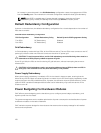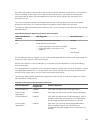
CMC allocates power to the CMC infrastructure and the servers in the chassis. CMC infrastructure
consists of components in the chassis, such as fans, I/O module, and storage adapters, PCIe cards,
physical disk, main board. The chassis may have up to four servers that communicate to the chassis
through an iDRAC. For more information, see the iDRAC User’s Guide at dell.com/support/manuals.
iDRAC provides CMC with its power envelope requirements before powering up the server. The power
envelope consists of the maximum and minimum power requirements necessary to keep the server
operating. iDRAC’s initial estimate is based on its initial understanding of components in the server. After
operation commences and further components are discovered, iDRAC may increase or decrease its initial
power requirements.
When a server is turned on in an enclosure, the iDRAC software reestimates the power requirements and
requests a subsequent change in the power envelope.
CMC supplies the requested power to the server, and the allocated wattage is subtracted from the
available budget. After the server is granted a power request, the server's iDRAC software continuously
monitors the actual power consumption. On the basis of actual power requirements, the iDRAC power
envelope may change over a period of time. iDRAC requests a power step up if the servers are fully using
the allocated power.
Under heavy load, the performance of the processors on the server may be degraded to ensure power
consumption stays lower than the user-configured System Input Power Cap.
The PowerEdge VRTX enclosure can supply enough power for peak performance of most server
configurations, but many available server configurations do not consume the maximum power that the
enclosure can supply. To help datacenters allocate power for their enclosures, the PowerEdge VRTX
allows you to specify a System Input Power Cap to make sure that the overall chassis AC power draw
stays within a given threshold point. CMC first makes sure that enough power is available to run the fans,
I/O module, storage adapters, physical disk drive, main board, and CMC itself. This power allocation is
called the Input Power Allocated to Chassis Infrastructure. After Chassis infrastructure, the servers in an
enclosure are turned on. Any attempt to set a System Input Power Cap less than the “Power Burden” will
not be successful. Power Burden is the sum of power allocated to the infrastructure and the minimum
power allocated for the powered servers.
NOTE: To use the Power Cap feature, you must have an Enterprise License.
If necessary for the total power budget to stay below the value of the System Input Power Cap, CMC
allocates servers a value less than their maximum requested power. Servers are allocated power based on
their Server Priority setting, with higher priority servers getting maximum power, priority 2 servers getting
power after priority 1 servers, and so on. Lower priority servers may get less power than priority-one
servers based on System Input Max Power Capacity, and the user-configured setting of System Input
Power Cap.
Configuration changes, such as an additional server, shared HDDs, or PCIe cards in the chassis, may
require the
System Input Power Cap to be increased. Power needs in a modular enclosure also increase
when thermal conditions change and the fans are required to run at higher speed, which causes them to
consume additional power. Insertion of I/O module and storage adapters, PCIe cards, physical disk, main
board; number, type, and configuration of PSUs also increase the power needs of the modular enclosure.
A fairly small amount of power is consumed by servers even when they are powered down to keep the
management controller powered up.
179


















